
Thelesperma filifolium, commonly known as stiff greenthread, or plains greenthread, is a species of flowering plant in the aster family, Asteraceae. It is often found growing in shallow soils. It prefers disturbed sites in dry, sandy or gravelly soil with a neutral to basic pH. Stiff greenthread adapts to various soil conditions, including loam, clay, caliche, and roadsides. It blooms between March and June and often into the fall.

Symphyotrichum frondosum is a species of flowering plant in the family Asteraceae native to western North America. Commonly known as short-rayed alkali aster, it is an annual or perennial herbaceous plant that may reach 140 centimeters tall.

Thelesperma is a genus of North American and South American plants in the cosmos tribe within the sunflower family. Greenthread is a common name for plants in this genus.

Solidago nemoralis is a species of flowering plant in the family Asteraceae. It is native to North America, where it is widely found in Canada and the United States. Its common names include gray goldenrod, gray-stem goldenrod, old-field goldenrod, field goldenrod, prairie goldenrod, dwarf goldenrod, and dyersweed goldenrod.
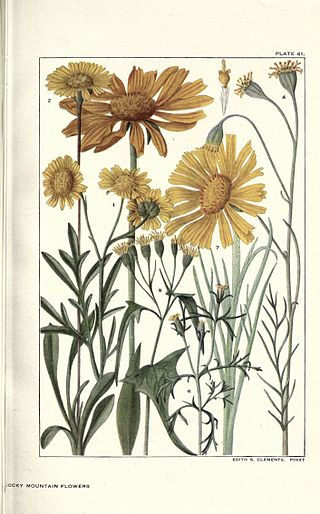
Pericome caudata is a species of flowering plant in the aster family known by the common name mountain tail-leaf. It is native to the southwestern United States as far east as Colorado, Oklahoma, and Texas, as well as northern Mexico, where it grows in rocky habitat, often in hills and mountains, and sometimes in disturbed areas. It is a large, branching, leafy perennial herb or subshrub approaching 2 meters in maximum height. It is glandular, resinous, sparsely hairy, and aromatic. The leaves are somewhat triangular, sometimes with a few large teeth or sharp lobes, the blade measuring up to 12 centimeters long and borne on a petiole. The leaf size and shape is variable across the species' range. The inflorescence is a cluster of many flower heads each under a centimeter wide and filled with golden yellow disc florets. The Navajo used this plant for a variety of medicinal and ceremonial purposes.

Pyrrocoma carthamoides is a species of flowering plant in the family Asteraceae known by the common name largeflower goldenweed. It is native to western North America from British Columbia to northeastern California to Wyoming, where it is known from grassland, woodlands, forests, barren areas, and other habitat. It is a perennial herb growing from a taproot and producing one or more stems to about half a meter in maximum length, the stems reddish-green and leafy. The largest leaves are at the base of the stem, measuring up to 20 centimeters long, lance-shaped with spiny sawtoothed edges. Leaves higher on the stem are smaller and hairier. The inflorescence is a single flower head or a cluster of up to four. Each bell-shaped head is lined with phyllaries each up to 2 centimeters long. It has many yellow disc florets surrounded by a fringe of yellow ray florets up to 7 millimeters long; ray florets are occasionally absent. The fruit is an achene which may be well over a centimeter in length including its pappus.

Pyrrocoma racemosa is a species of flowering plant in the family Asteraceae known by the common name clustered goldenweed. It is native to the western United States, where it grows in many types of habitat. It is quite variable in morphology, and there are several varieties which are sometimes hard to tell apart. In general, it is a perennial herb usually producing two or more mostly erect stems reaching maximum heights between 15 and 90 centimeters. The stems are reddish or brownish in color, leafy or not, and hairless to quite woolly. The longest leaves are located in tufts around the base of the stems. They are lance-shaped to oval, smooth-edged, wavy, or deeply spine-toothed, and may exceed 30 centimeters in length. Basal leaves are borne on woolly petioles. Leaves located higher on the stem lack petioles and may clasp the stem at their bases. The inflorescence is a cluster of several flower heads lined with phyllaries which may be over a centimeter long and are hairy to hairless in texture. Each head contains many yellow disc florets and a fringe of several yellow ray florets. The fruit is an achene which may be over a centimeter long including its pappus.
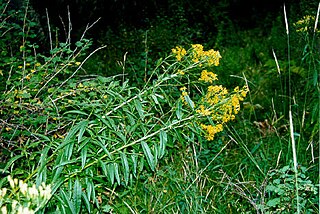
Senecio serra is a species of flowering plant in the aster family known by the common names tall ragwort and sawtooth groundsel. It is native to the western United States, where it can be found in several types of habitat, including sagebrush and woodlands. It is a perennial herb producing a single erect stem or a cluster of stems from a branched, woody caudex. The plant can exceed two meters in height. It is hairless in texture, with young plants sometimes appearing fuzzy, and green to red-tinged in color. The leaves have lance-shaped blades up to 20 centimeters long borne on short petioles, the leaves occurring evenly all along the stems. The inflorescence is a spreading array of many flower heads, each lined with green- or black-tipped phyllaries. The heads contain yellow disc florets and 5 to 8 yellow ray florets each under a centimeter long.

Solidago multiradiata is a species of goldenrod known by the common names Rocky Mountain goldenrod, northern goldenrod, and alpine goldenrod. It is native to North America, where it can be found throughout the northern regions, including Alaska and most of Canada (all 3 territories plus all provinces except Prince Edward Island, including territory north of the Arctic Circle. Its distribution extends through the western United States as far south as Arizona, New Mexico, and California. It is known mostly from the subalpine and alpine climates of high mountain ranges. Its habitat includes tundra and mountain meadows.

Solidago spectabilis is a species of goldenrod known by the common names Nevada goldenrod, basin goldenrod, and showy goldenrod. It is native to the western United States in the Great Basin and surrounding areas. It is found in California, Arizona, Nevada, Oregon, and Utah. There are historical records saying it once grew in southwestern Idaho, but is now extirpated there. This variety has also been seen in the western Montana county of Sanders.

Stanleya pinnata is a species of flowering plant in the family Brassicaceae known as desert prince's-plume. It is a perennial herb or shrub native to North America.
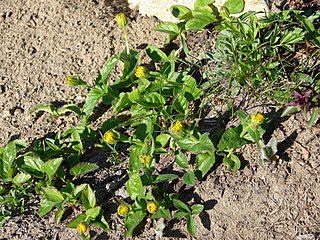
Tonestus lyallii is a species of flowering plant in the family Asteraceae known by the common names Lyall's goldenweed, Lyall's serpentweed and Lyall's tonestus. It is native to western North America, particularly in the Rocky Mountains and the mountain ranges of the Pacific Northwest with scattered occurrences between. It is a perennial herb growing in clumps or short bunches not more than about 15 centimeters tall, the stem branching from a tough caudex. The leaves are smooth-edged and linear or lance-shaped, the largest at the base of the plant reaching up to about 8 centimeters long. The inflorescence is a single flower head or a pair of heads each about a centimeter wide with green or red phyllaries. The head bears at least 10 or 11 bright yellow ray florets around a center containing many tubular disc florets.
Townsendia leptotes is a species of flowering plant in the family Asteraceae known by the common names common Townsend daisy and slender townsendia. It is native to the western United States, where it grows in the alpine climates of high mountain ranges from California to Montana to New Mexico.
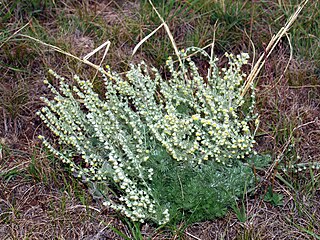
Artemisia frigida is a widespread species of flowering plant in the aster family, which is known as the sunflower family. It is native to Europe, Asia, and much of North America. In parts of the north-central and northeastern United States it is an introduced species.
See also Zuni ethnobotany, and Native American ethnobotany.

Tetraneuris acaulis is a North American species of flowering plants in the sunflower family. Common names include angelita daisy, stemless four-nerve daisy, stemless hymenoxys, butte marigold, and stemless rubberweed.
Erigeron arisolius is a species of flowering plant in the family Asteraceae known by the common names arid throne fleabane and dry-sun fleabane. It is native to the southwestern United States (Arizona) and northwestern Mexico (Sonora).
Erigeron versicolor is a rare North American species of flowering plant in the family Asteraceae known by the common names bald-fruit fleabane and changing fleabane. It is native to the southwestern United States and northern and central Mexico as far south as Michoacán.
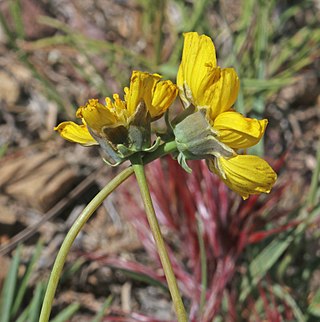
Thelesperma subnudum, commonly known as Navajo tea, is a perennial species of flowering plant in the family Asteraceae. It is found from west central Canada to central United States. It grows in openings in pinyon/juniper or yellow pine forests.
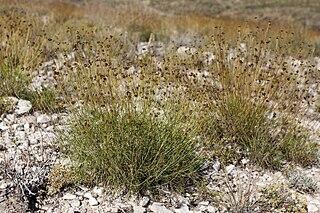
Thelesperma longipes, the longstalk greenthread, is a perennial species of flowering plant in the aster family. It is found from Arizona to northeast Mexico.

















